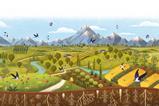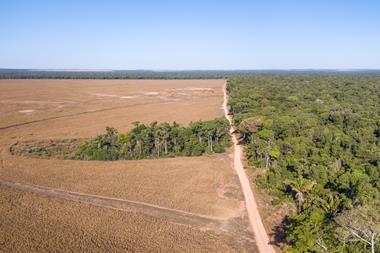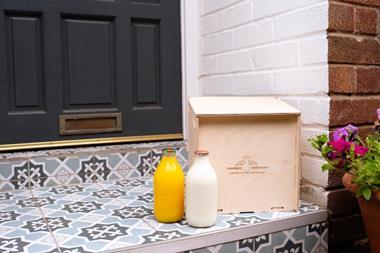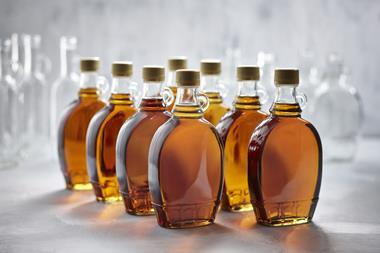To successfully tackle the impact of inflation, supply chain issues and the climate crisis, food needs a fundamental redesign. Here’s why it’s more straightforward than you think.
Feeding the 8 billion people alive today is one of the most environmentally damaging human activities, responsible for a third of global carbon emissions and half of all biodiversity loss.
But it needn’t be this way. Food can be a force for good, helping to reverse the damage our species has done to the planet. After all, the country’s 10 biggest FMCG manufacturers and retailers wield huge power, influencing how approximately 50% of British farmland is used.
This puts them in a unique position to drive change. “Rather than bending nature to produce food, food can be designed for nature to thrive,” says Gaëlle Le Gélard, design manager at the Ellen MacArthur Foundation, which outlined how food producers, brands and retailers can help drive the regeneration of nature in its pioneering 2021 study The Big Food Redesign.
“If we don’t fix food, we can’t fix the climate crisis. But retailers and manufacturers have it in their grasp to build a system that is regenerative by design because they have such huge buying power. They can design products to be nature positive by using more diverse, lower impact, regeneratively produced and upcycled ingredients. That is a really powerful idea.”
But what would the big food redesign look like in practice? And what practical steps can supermarkets and their suppliers take to redesign food and drink so that their products have a positive impact on the environment?
Step 1: Diversify your ingredients
Earth’s plummeting biodiversity reflects what’s going on in our diets: they are becoming less diverse. There are some 300,000 edible plants on earth, yet just four (wheat, rice, corn and potatoes) provide 60% of our calories. This exposes food supply chains to greater risk from weather shocks and disease and jeopardises Earth’s ability to sustain future generations.
For instance, there are 4,500 varieties of potato, yet we use just a handful, suggesting the lessons of the Great Famine in 19th century Ireland have been forgotten. Examples of this over-reliance on too few varieties can be found in everything from bananas to cereals.
This can be fixed. If supermarkets broaden their fresh produce ranges and manufacturers design products using more diverse ingredients, they will help lower the risk posed by pests, climate change and other environmental factors. Diversity can also drive consumer interest (who doesn’t love a purple carrot?) and give brands a valuable point of difference.

Step 2: Switch to regeneratively grown ingredients
How ingredients are produced is also crucial. Growing numbers of manufacturers say they are looking to switch to regenerative methods that enhance biodiversity, soil, water and air quality. Growing crops alongside native plant and animal species cuts reliance on artificial fertilisers and pesticides, while reducing carbon emissions and boosting biodiversity.
They recognise that this is no mean feat. “To transform global food systems, we must completely rethink how we grow our food. We are working directly with more than 50,000 farms across the world to help them change how they manage land and livestock, to help tackle climate change and biodiversity loss,” says a spokesperson from Danone.
If all this sounds like some sort of rose-tinted utopia, think again. Planting wheat alongside peas or other legumes, which work as natural fertilisers by fixing nitrogen in the soil, or grazing livestock on land sown with arable crops (think of all that manure!) can increase total food output on average by 5% and profits per hectare by $200.
Step 3: Change the way you view waste
Modern agriculture and the food systems it feeds are hugely wasteful. Currently, 1.2 billion tonnes of waste, worth $370bn, are produced globally every year. Changing the way we view waste will help pay huge dividends for the planet and producers.
Examples abound. Using the sweetness of coffee cherries, which are mostly discarded and left to rot, could cut 16.6 million tonnes of carbon going into the atmosphere (equivalent to 730k transatlantic flights) a year. Upcycling ‘ugly’ fruit, apple and pear by-products as sweeteners could allow an area the size of Luxembourg to be spared from sugar cane or beet, allowing biodiversity to be restored.
Step 4: Select lower impact ingredients
Not all ingredients are created equal, clearly. There are already many alternative ingredients which are available in large volumes but have few negative climate and biodiversity impacts. Such as switching from conventially produced cows milk to alternatives such as oats, peas, almonds or walnuts.
This doesn’t mean the world should ditch dairy. Cows’ milk is a vital source of nutrients and around 60% of grassland used is unsuitable for growing crops. Rather, livestock can be integrated into regenerative systems that produce a range of crops. Rather, livestock can be integrated into regenerative systems that produce a range of ingredients, in addition to non-food products such as leather.
What would redesigned food products look like?
Switching ingredients or packaging materials is not enough. To make real progress in making food that works with nature not against it, manufacturers need to redesign their products from the ground up. But what would that look like? Here are four concepts from the Ellen MacArthur Foundation…

Down to Earth Potatoes
Despite there being more than 4,500 types of potato to choose from, humankind relies heavily on just a handful of varieties. Down to Earth changes that, by presenting a new line of delicious and resilient potatoes grown in a way that cuts carbon emissions and boosts biodiversity.
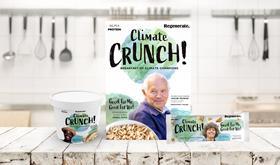
Regenerate Climate Crunch
This range of breakfast cereals and snack bars are made using regeneratively grown wheat and peas. Legumes such as peas are superheroes of the plant-world because they can fix the essential element nitrogen into the soil from the atmosphere, cutting the need for synthetic fertilisers. So, with every crunch, shoppers can help reverse climate change.

Silvo
Good news for cheese lovers: reversing food’s impact on the climate doesn’t mean you have to ditch dairy. Silvo is a range of indulgent dairy and walnut cheeses grown symbiotically using agroforestry techniques. While walnut trees trap carbon and provide shade for the cattle, the cows’ manure helps fertilise the trees. How’s that for circular?

Sweet Up
This range of moreish cookies are made from flours produced from by-products from the production of plant-based milk alternatives and sweetened with crop residues and pulp from cacao and fruit. By using materials that would otherwise go to waste, Sweet Up is helping to reduce global GHG emissions.
A circular future
By redesigning food along these lines, manufacturers and retailers can establish a truly circular economy and build a brighter future for humankind. Some of the worlds biggest are starting to take the necessary steps. “And the benefits go beyond that. Our analysis of a few ingredients in the EU and UK, show how a circular economy for food is a huge opportunity across the board – from reducing greenhouse gases and biodiversity loss to increasing yields and profitability,” says Le Gélard.
“Businesses can and must lead the transition through supporting farmers, leading product and supply chain innovation, and offering consumers more diverse, regeneratively sourced products.”
To find out more about the Ellen MacArthur Foundation’s big food redesign, read the report here.
All statistics taken from The Big Food Redesign unless otherwise stated












